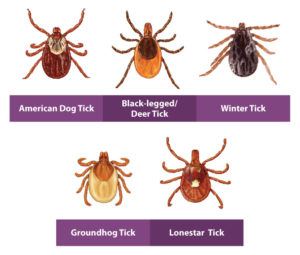Summertime Lyme on the Rise
Whether you’re heading to the Lake for a summer vacation or staying closer to home to enjoy the great outdoors, be on the lookout for the increasingly pervasive Black Legged (Deer) tick, purveyor of Lyme disease.
Frequent pet checks will help keep your pet – and your family – safe from Lyme disease, which has increased five-fold in the past decade throughout Michigan and is reaching what the CDC is calling epidemic proportions across America. The CDC estimates 300,000 cases last year, making Lyme the fastest growing vector-borne illness.
While lower Michigan had historically been spared a heavy infestation of Black Legged ticks – theoretically preserved from Illinois population due to Lake Michigan – migration continues from several counties in northern Indiana, which have reported ticks infected with B. burdorferi, the bacteria responsible for Lyme disease.
Black Legged ticks have become established throughout the entirety of the Lake Michigan shoreline in the Lower Peninsula. But tick populations are not staying confined to coastal counties, and are becoming established increasingly to the east in the southern part of the state, including Grand Rapids.
According to the Michigan Veterinary Medical Association, clinical Lyme disease in domestic animals may involve many organ systems. Fever, loss of appetite, depression, lethargy, swelling and pain in one or more joints, kidney disease, heart disease, and nervous system disorders have all been reported.
“An accurate diagnosis can only be made by a veterinarian. A Lyme disease vaccine is available. Consult your veterinarian about the appropriateness of vaccinating your pet and also to discuss recommendations for avoiding ticks,”
– Dr. Laurie Brush, founder of Heaven at Home Pet Hospice.
Last year, the FDA granted Nexgard the right to label the medication for Lyme disease prevention after clinical trials showed that the acaricide killed ticks before the disease could be transmitted, which typically takes 24-48 hours. Pet parents should discuss the risks and benefits of parasiticides with their routine care veterinarians because these types of medications all have the risk of possible side effects.
Other Ticks & Diseases Becoming Prevalent in Michigan
In the last decade, diseases spread by ticks, fleas and mosquitos tripled, according to the CDC. While many research papers point to climate change and milder winters for the rise in vector-borne illnesses, our highly mobile population also plays a role. Despite Michigan’s historical “protection” by the surrounding Great Lakes that slow the rise, the Companion Animal Parasite Council (CAPC) is predicting increase prevalence of diseases carried by ticks in the Great Lakes area in 2019.
Tick populations mate in the summer, increasing to peak populations in Fall.
Nationally, prevalence rates have risen each of the past 5 years and are now up 20% from 2013 levels, according to CAPC. The organization maintains an interactive map of diseases detected across North America:
Tick Types In Michigan:

Ticks to be on the lookout for include:
- American Dog Tick
- Black-legged Tick (Deer)
- Winter Tick
- Woodchuck Tick
- Lone Star Tick
These ticks can carry diseases such as Rocky Mountain Spotted Fever, Ehrlichia canis, and increasingly, Anaplasmosis.
The major vector of RMSF in Michigan is the American Dog tick, D. variabilis. It can also transmit the bacteria that causes Tularemia, and can harbor the Ehrlichiae bacteria.
In this video by the Companion Animal Parasite Council (CAPC), the council explains why the prevalence of the American Dog tick is of such grave concern. Essentially, as a tick that also infects animals in urban areas, it carries great potential to infect not only pets with diseases like Rocky Mountain Spotted Fever, but also another zoonotic disease (which means they can be transmitted to humans) that’s on the rise: Tularemia.
Tick-Borne Diseases:
- Rocky Mountain Spotted Fever Dogs are very susceptible to RMSF. Other small domestic mammals that are allowed outdoors or have contact with infected ticks may also contract this disease. Signs of RMSF include combinations of fever, lack of appetite, arthritis, shortness of breath, coughing, abdominal pain, nervous system disorders and swelling of the face or extremities. Small hemorrhages on the mucous membranes occur in severe cases. Transmission from dogs to humans does not occur, but people should exercise caution when removing ticks from pets, as the fluids from the tick can carry the RMSF organism.
- Ehrlichia canis is the disease in dogs, caused by Ehrlichia canis, and other Ehrlichia species, mimics RMSF.
- Tularemia is a bacterial disease caused by Francisella tularensis and is often referred to as rabbit fever. Tularemia is most commonly found in rabbits and rodents, and it survives by creating tumor-like masses and abscesses in the victim animal’s liver. Tularemia is often self-limiting although some dogs experience short periods of poor appetite, lethargy, and mild fever. Less frequently, dogs may show conjunctivitis, uveitis (inflammation in their eyes), draining abscesses, and enlarged lymph nodes.
- Anaplasmosis, aka dog fever or dog tick fever, is a tick-borne disease that infects a dog’s bloodstream. The most common form of the disease is transmitted by deer tick bites and infects white blood cells. A second type, carried by the brown dog tick, affects the blood-clotting cells known as platelets. This disease can also infect humans and is common throughout the United States. CAPC predicts it will be highly active in the Great Lake States this year.
How to Check Your Dog for Ticks – What AKC Recommends:
1. Inside of Ears – Ticks sit themselves on tall grasses and shrubs, waiting for your dog to walk by, so they can attach themselves to him. With so many crevices and hiding places, the ears make a perfect home for a hungry tick. When checking your dog, make sure to look deep into the ear, because the ticks can get attached and go unnoticed for a long time. If your dog is shaking and scratching at his ear, it’s a sure sign that something is off, and you’ll want to take a look.

2. Between Toes – Since ticks like to hide in places where they won’t be found, crawling in-between your dog’s toes and attaching there is a common occurrence. You can find them in-between the toes or even on the bottom of the foot near the pads.
3. Under the Tail – Ticks like dark, moist areas, so the underside of the tail makes a great home. If your dog has thick fur, you’ll want to make sure to comb through it and search thoroughly. A fine comb will likely catch a tick that’s attached itself under the tail.
4. In the Genital Region – Most dog owners aren’t keen on checking their dog’s genital regions. However, this area is another dark, moist region on the body that attracts ticks.
5. Around Eyelids – Ticks go unnoticed near the eyelids because they’re mistaken for skin tags or eye discharge. Unfortunately, by the time many owners realize there is a tick on their dog’s eyelid, the tick has been attached for quite a while.
6. Under the Collar – Many dogs rarely have their collars taken off. Ticks can become attached underneath your dog’s collar without anyone noticing, usually until the tick is large enough to be seen — which means it’s been there for a while. Remove the collar to do a thorough check for ticks.
How to Safely Remove a Tick
1. Using fine-tipped tweezers, grasp the tick by the head as close to the skin as possible.
2. Then gently, but firmly, pull it straight out. Do not: twist or jerk the tick, apply petroleum jelly, a hot match, or other irritants. This can lead to infection because the tick’s mouth parts may remain embedded, or you may be burned. Use your fingernails and tissue paper if tweezers are not available.
3. Immediately wash the bite area and your hands with soap and water then apply an antiseptic to the bite wound.
- If in doubt of tick identification, place the tick in a small vial containing a damp piece of tissue and submit it to your local health department for examination.
Tips from Tufts University on Reducing Tick Risk:
1. Take care of your yard. Mowing the lawn regularly will make your backyard less attractive to ticks. Be sure to pull tall weeds and to remove leaf litter, particularly from under shrubs and around the perimeter, because that’s where ticks hide. Secure your outdoor trash cans to discourage rodents that carry deer ticks.
2. Use a tick preventive on your pet. Make sure you choose a veterinarian-recommended product that is safe for all the animals in your household.
3. Check your animals for ticks daily. If your pets spend time outside, feel them for bumps, parting their fur so you can see where the coat meets the skin. Pay particular attention to under the legs, around the neck and inside the ears.
4. Talk to your veterinarian about a canine Lyme vaccine. Some research suggests that vaccination appears to work well in preventing infection in dogs not previously exposed to the Lyme bacterium. However, it’s still important to use a tick preventive on your pet.
5. Protect yourself. Use repellent, wear treated clothing, shower after being outside and regularly check yourself for ticks. They can hop from you to your pet.
- Since it can take 24 to 48 hours for an attached tick to transmit an infection to its host, prompt and proper removal is helpful in preventing disease onset.




